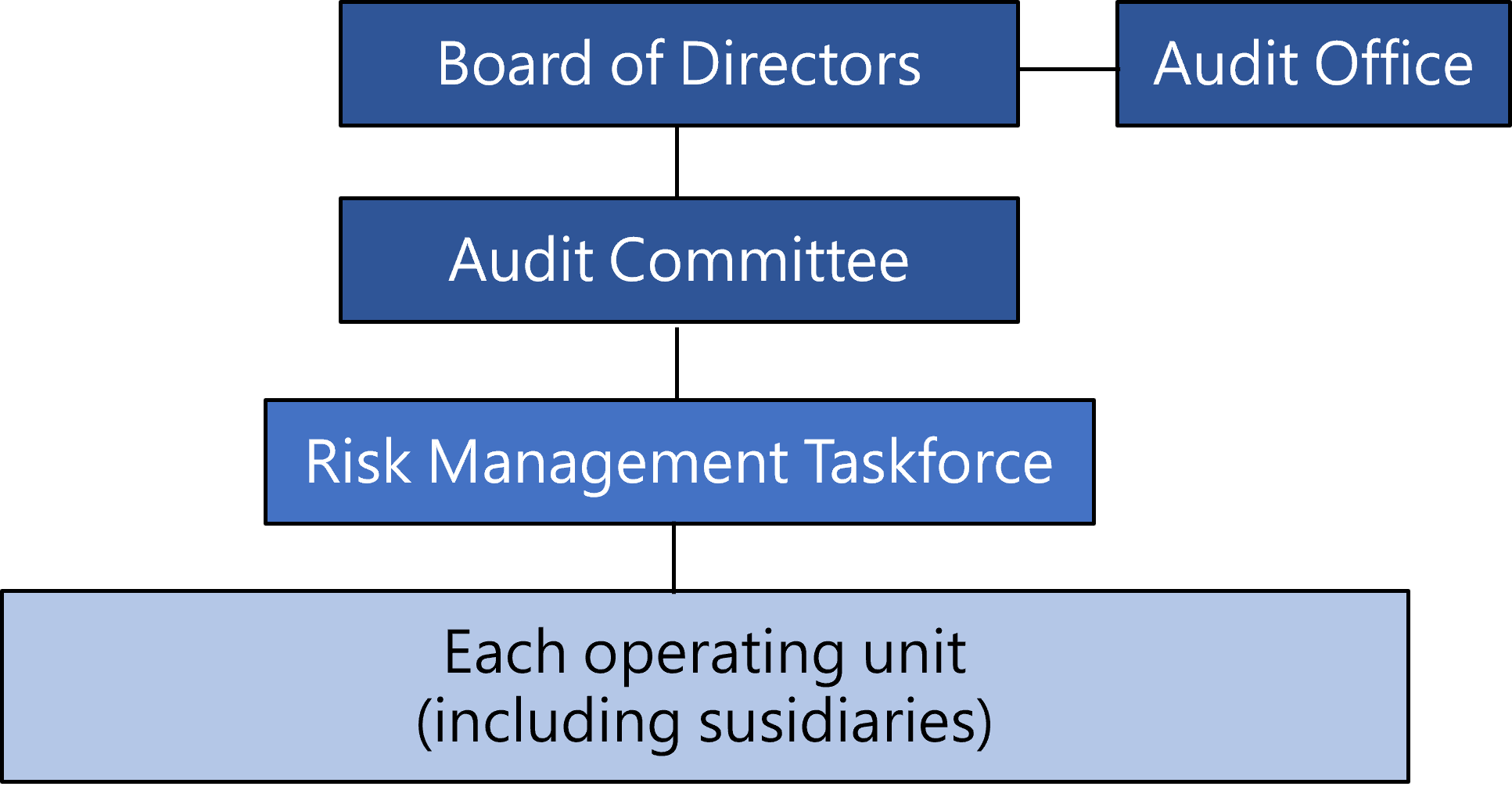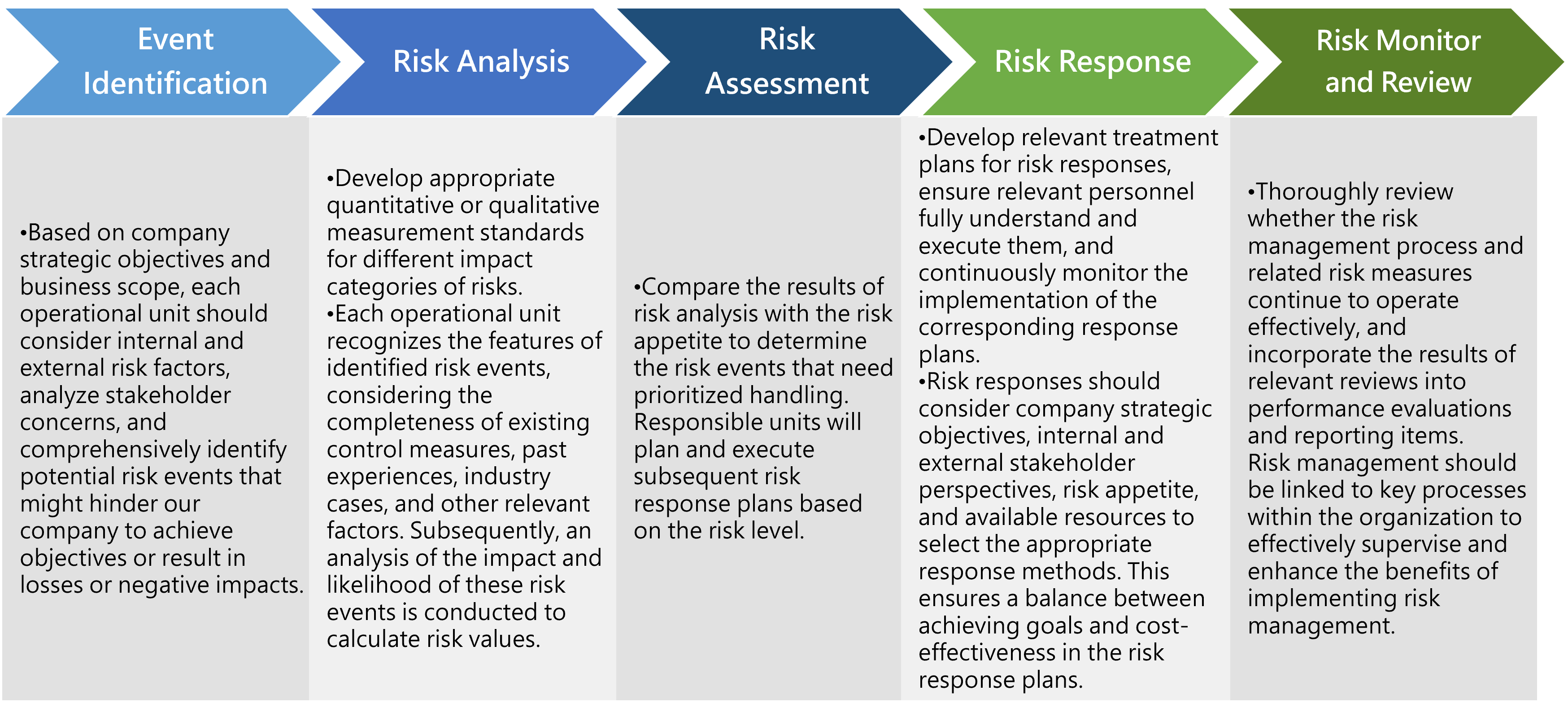
Risk Management
Risk Management Policy
On December 15, 2020, Chia Hsin Cement Group first formulated a risk management policy. In order to continuously improve and establish a comprehensive risk management system, we referred to the “Practical Guidelines for Risk Management of Listed and OTC Companies” issued by the Taiwan Stock Exchange on August 8, 2022, to revise this policy and procedures. The revisions were then approved by the Board of Directors(BOD) on December 15, 2023. For detailed information, please refer to the “Risk Management Policy and Procedures”.
Risk Management Framework
- The BOD serves as the highest governing body for risk management. It approves risk management policies and related regulations, oversees the overall implementation of risk management, and maintains effective risk control.
- The Audit Committee assists the BOD in carrying out its risk management duties and establishes a risk management taskforce conducting comprehensive assessments of the company’s strategies, operations, legal compliance, finance, emerging and other risks. In response, the risk management taskforce reports the risk management operations to the Audit Committee and the BOD at least once a year.
 Members of the risk management taskforce are equipped with diverse professions from different departments, including macroeconomics, strategic management, investment, risk management, internal audit, human resources, finance, legal affairs, and sustainable development. This composition ensures various perspectives contribute to more comprehensive opinions during discussions and execution.
Members of the risk management taskforce are equipped with diverse professions from different departments, including macroeconomics, strategic management, investment, risk management, internal audit, human resources, finance, legal affairs, and sustainable development. This composition ensures various perspectives contribute to more comprehensive opinions during discussions and execution.- Each operating unit (including subsidiaries):
- Responsible for risk identification, analysis, assessment, and response.
- Regularly report risk management information to the risk management taskforce.
- Maintain the implementation of risk management effectiveness and related control procedures in accordance with the risk management policy.
- The Auditing Office is an independent organization in the company affiliated with the BOD. Annually, it reviews whether the risk management taskforce enforces the identification, analysis, response, and other related measures for various risk items consistent with risk management policy and procedure. During the execution of the annual audit plan, it also verifies the effectiveness of risk management activities to assist in properly managing significant operational risks
Risk Management Procedures

Risk Management Operation Status
- The update report on the management results of significant risk events in 2023 was submitted to the Audit Committee on August 8, 2023.
- The interim progress report of the risk control project for 2023 was presented to the BOD on November 8, 2023.
- The risk assessment report for 2024 was reported to the Audit Committee and the BOD on December 15, 2023.
Risk Trainings in 2023
| Course Content | Hours | Target participants |
| Global Future Risks and Opportunities for Sustainable Transformation | 3 hours | All the board members, department heads, and designated colleagues |
| Corporate Sustainability and Risk Management | 3 hours | Managers and department heads of each company |
| Fundamental Concepts of Risk Management | 3 hours | Sales and designated personnel in business and logistics |
| Risk Assessment Workshop (Note) | 21 hours | Managers, department heads, and designated personnel in each company |
- (Note) In order to establish effective risk awareness and risk culture, external consultants were commissioned for the first time in 2023 to conduct seven risk assessment workshops. During the workshops, colleagues actively discussed the content of the questionnaire, achieving consensus, confirming any oversight, and conducting risk assessments.
Important Risks and *Emerging Risks
| Risk Description | Impact | Effectiveness | Possibility | Solution |
| Building durability, safety, and legality | Revenue reduction / Employee safety / Capital expenditure | Medium | Medium | ● Regularly review and assess the safety and legality of the building, and plan and execute relevant maintenance and repair projects ● Phased planning and updating of important equipment and systems in the building ● Introduce green building certification and conduct targeted marketing for the identified customer segments |
| *Policy changes towards achieving net-zero carbon emissions by 2050 | Revenue reduction / Increased operational costs/ Corporate reputation | Medium | Medium | ● Actively seek new business opportunities and development directions ● Negotiate contract modifications with the Taiwan international ports corporation timely based on market demands and development trends ● Track and understand government policies and regulations, and duly propose responsive measures ● Implement a carbon reduction plan with the goal of obtaining SBTi certification |
| Extreme climate | Property losses/ Employee safety | Medium | Medium | ● Establish comprehensive plans for ongoing operations, crisis management, and response plan, also conduct regular reviews ● Periodically assess and enhance the resilience of infrastructure ● Increase or ensure that insurance coverage meets the requirements |
| *Labor shortages due to issues such as declining birth rates and regional factors | Impact on operations/ Rising personnel costs | Medium | High | ● Enhance employer brand image, adopt a diverse hiring policy, and create an inclusive and equal workplace environment ● Continuously follow industry and workforce development trends, and regularly adjust recruitment and training plans ●Consider industry-standard salary rates and benefits conditions to provide attractive compensation packages ● Offer professional training and development plans for employees ● Conduct regular interviews with employees through various channels to gather feedback ● Continuously optimize operational processes to improve working efficiency |
| Ongoing business risks triggered by External factors such as geopolitical tensions or infectious diseases | Equipment losses/ Revenue reduction / Impact on reputation | High | Medium | ● Establish comprehensive plans for ongoing operations, crisis management, and response, and conduct regular reviews ● Build a diversified supply chain ● Regularly organize training courses and exercises to enhance employee response capabilities ● Continuously monitor government and relevant agency-issued alert information |
| Increase in operational costs due to inflation or other external factors | Increased operational costs | Medium | Medium | ● Regularly review costs and expenses, conduct cost-benefit analyses, and implement appropriate response measures ● Enhance operational efficiency through digitalization ● Expand cooperation with different suppliers, establish a high-quality vendor database, and ensure reliable and reasonably priced alternative sources ● Introduce energy-saving equipment to improve energy efficiency and reduce energy expenditures effectively |

